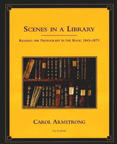 |
Carol Armstrong. Scenes in a Library: Reading the Photograph in the Book, 1843-1875. Cambridge, MA: The MIT Press, 1998.
When I was a student of Carol Armstrong’s at Hunter College and the CUNY Graduate Center, she always challenged me to look deeper at the photograph, to plumb its many fine layers of meaning and shades of critical interpretation. It is through Armstrong that I discovered the complexity of Roland Barthes’ Camera Lucida, perhaps the most extraordinary writing on photography of the 20th century and an important part of the structure of Armstrong’s narrative.
Scenes in a Library, in Armstrong’s words, “reinscribe[s] the 19th-century photograph in its textural surround, and if art history or the art museum have removed it from its album series or book pages, to reinsert it there.” Her method placed photography back in its original discursive context and cast a critical eye on established institutions’ constructions of history. |